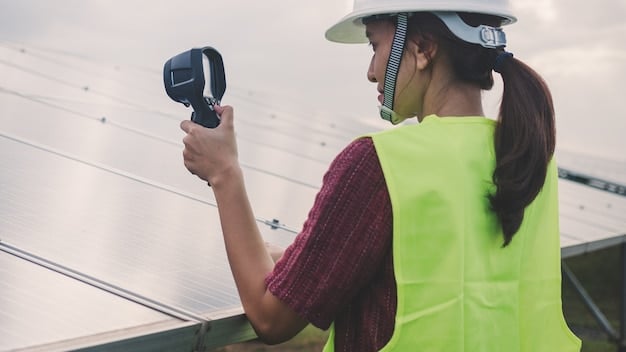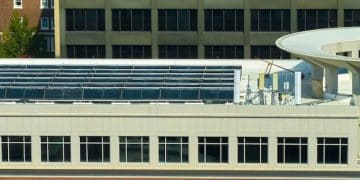Energy Prices in 2025: Saving Tips for US Businesses

Energy prices in 2025 are projected to remain volatile, but US businesses can mitigate the impact by implementing energy-efficient technologies, optimizing operational practices, and exploring renewable energy sources to reduce consumption and costs.
Navigating rising energy costs is a top priority for US businesses. With projections indicating continued volatility in energy prices in 2025: How to Reduce Your Business’s Energy Consumption and Costs, understanding how to mitigate these increasing expenses is crucial.
Understanding the Energy Market Outlook for 2025
The energy market is constantly evolving, influenced by geopolitical events, technological advancements, and shifting consumer demands. For businesses in the US, staying informed about the 2025 outlook is essential for effective energy management and cost control.
Factors Influencing Energy Prices
Several key factors are expected to shape energy prices in the coming years. Understanding these underlying dynamics is the first step toward developing effective strategies to mitigate their impact.
- Geopolitical Instability: Global events such as conflicts and trade disputes can disrupt energy supply chains, leading to price fluctuations.
- Economic Growth: Increased economic activity typically drives up energy demand, putting upward pressure on prices.
- Regulatory Changes: Government policies related to energy production, consumption, and emissions can significantly impact market dynamics.
- Technological Innovation: Advancements in renewable energy, energy storage, and efficiency technologies can alter the energy landscape and influence prices.
Businesses must carefully consider these factors when forecasting their energy needs and budgeting for future expenses. By understanding the potential risks and opportunities, they can make more informed decisions about their energy strategies.
In conclusion, being proactive and informed about the energy market outlook in 2025 is vital for US businesses to manage their energy consumption and costs effectively.
Conducting an Energy Audit for Your Business
Before implementing any energy-saving measures, it’s important to understand how your business currently uses energy. An energy audit can provide a comprehensive assessment of your energy consumption patterns and identify areas for improvement.
An energy audit involves a thorough examination of your business’s energy-related systems and practices. This includes everything from lighting and HVAC to equipment and processes. The goal is to identify inefficiencies and opportunities for reducing energy consumption.

- Assess Current Energy Use: Analyze utility bills and usage data to establish a baseline of energy consumption.
- Evaluate Equipment Efficiency: Inspect HVAC systems, lighting, and other equipment to identify potential upgrades or replacements.
- Identify Energy Waste: Look for areas where energy is being wasted, such as leaky windows, poorly insulated walls, or inefficient processes.
- Develop Recommendations: Based on the audit findings, create a prioritized list of energy-saving measures with estimated costs and benefits.
The results of an energy audit can serve as a roadmap for implementing energy-efficient upgrades and optimizing operational practices, leading to significant cost savings and reduced environmental impact.
Understanding where your business is wasting energy helps you create a targeted plan for 2025 and beyond.
Implementing Energy-Efficient Technologies
Investing in energy-efficient technologies is a key strategy for reducing business energy consumption and costs. These technologies can improve overall efficiency, lower utility bills, and minimize environmental impact.
LED Lighting
Switching to LED lighting is one of the simplest and most effective ways to reduce energy consumption. LEDs use significantly less energy than traditional incandescent or fluorescent bulbs and have a much longer lifespan.
Smart Thermostats
Smart thermostats allow businesses to automate their HVAC systems and optimize energy usage. These devices can learn occupancy patterns and adjust temperature settings accordingly, reducing energy waste when spaces are unoccupied.
Consider these additional upgrades:
- High-Efficiency HVAC Systems: Upgrading to newer, more efficient HVAC systems can significantly reduce energy consumption for heating and cooling.
- Energy-Efficient Appliances: Replacing old appliances with ENERGY STAR-certified models can lead to substantial energy savings over time.
- Building Automation Systems: Implementing a building automation system allows businesses to monitor and control energy use across various systems, such as lighting, HVAC, and security.
By implementing these technologies, businesses can create a more sustainable and cost-effective energy management strategy.
Energy-efficient technologies contribute significantly to lowering your business’s utility bills.
Optimizing Operational Practices for Energy Savings
Beyond investing in new technologies, businesses can also reduce energy consumption by optimizing their operational practices. These changes often require little or no upfront investment and can yield significant savings.
Employee Training and Awareness
Educating employees about energy conservation practices is essential for fostering a culture of sustainability. Training can include tips on turning off lights and equipment when not in use, adjusting thermostat settings, and identifying energy waste.
Equipment Maintenance
Regular maintenance of equipment such as HVAC systems, machinery, and appliances can improve their efficiency and prolong their lifespan. This includes tasks such as changing filters, lubricating moving parts, and checking for leaks.
Consider these further operational practices:
- Scheduling and Automation: Implement scheduling and automation systems to control lighting, HVAC, and equipment based on occupancy and usage patterns.
- Process Optimization: Review operational processes to identify opportunities for reducing energy consumption, such as streamlining production lines or optimizing delivery routes.
- Remote Work Policies: Encourage remote work policies where possible to reduce energy consumption in office buildings.

Optimizing operational practices can lead to significant savings in energy consumption and costs. By implementing these changes and fostering a culture of sustainability, businesses can reduce their environmental impact.
Many operational changes require minimal investment but result in substantial long-term savings.
Exploring Renewable Energy Sources
Investing in renewable energy sources such as solar, wind, and geothermal can provide long-term energy cost savings and reduce your business’s carbon footprint. While the initial investment may be higher, the long-term benefits often outweigh the costs.
Solar power is one of the most popular renewable energy options for businesses. Solar panels can be installed on rooftops or in open spaces to generate electricity, reducing reliance on traditional grid power.
Wind power is another viable option, particularly for businesses located in areas with consistent wind resources. Small-scale wind turbines can be used to generate electricity for on-site consumption.
These options offer alternatives for your business:
- Geothermal Energy: Geothermal systems use the Earth’s constant underground temperature to heat and cool buildings, providing a renewable and energy-efficient alternative to traditional HVAC systems.
- Power Purchase Agreements (PPAs): Enter into PPAs with renewable energy providers to purchase electricity at a fixed price, providing long-term cost certainty.
- Green Energy Tariffs: Opt for green energy tariffs offered by utility companies, which provide electricity generated from renewable sources.
There are more incentives for businesses to transition to renewable energy.
Investing in renewable energy sources can provide long-term energy cost savings.
Financing Options and Incentives for Energy Efficiency
Many financing options and incentives are available to help businesses invest in energy efficiency and renewable energy projects. These resources can significantly reduce the upfront costs and make sustainable investments more accessible.
Government Loans and Grants
Federal, state, and local governments offer various loan and grant programs to support energy efficiency and renewable energy projects.
Tax Credits and Rebates
Tax credits and rebates can significantly reduce the cost of energy-efficient equipment and renewable energy systems. These incentives are often available for both residential and commercial customers.
These incentives are available for your business:
- Utility Company Programs: Many utility companies offer rebates, incentives, and financing options to encourage customers to invest in energy-efficient technologies.
- Energy Savings Performance Contracts (ESPCs): ESPCs allow businesses to partner with energy service companies (ESCOs) to implement energy efficiency projects with no upfront capital investment.
- Private Financing: Banks and other financial institutions offer loans and leasing options for energy efficiency and renewable energy projects.
Financing options and incentives can make energy-efficient and renewable energy projects more affordable.
The available financial assistance makes sustainable investment easier for businesses.
| Key Point | Brief Description |
|---|---|
| 💡 Energy Audit | Identify areas of energy waste in your business operations. |
| 💰 Incentives | Explore government and utility incentives for efficiency upgrades. |
| ☀️ Renewable Energy | Consider solar or other renewable energy sources for long-term savings. |
| ⚙️ Operational Practices | Optimize your business’s day-to-day energy use. |
Frequently Asked Questions
▼
An energy audit pinpoints areas of energy waste, guiding targeted improvements for lower bills and a smaller environmental footprint.
▼
Switch to LED lighting, use power strips to fully switch off electronics, and adjust thermostat settings, can make a difference.
▼
Yes, federal and state governments often provide tax credits and incentives for installing solar panels.
▼
Regular maintenance ensures equipment runs efficiently, preventing energy waste from poorly operating systems and machinery.
▼
A Power Purchase Agreement (PPA) is an agreement to buy electricity from a renewable energy provider at a fixed price.
Conclusion
By implementing energy-efficient technologies, optimizing operational practices, and exploring renewable energy sources, US businesses can effectively reduce their energy consumption and costs in 2025 and beyond.





